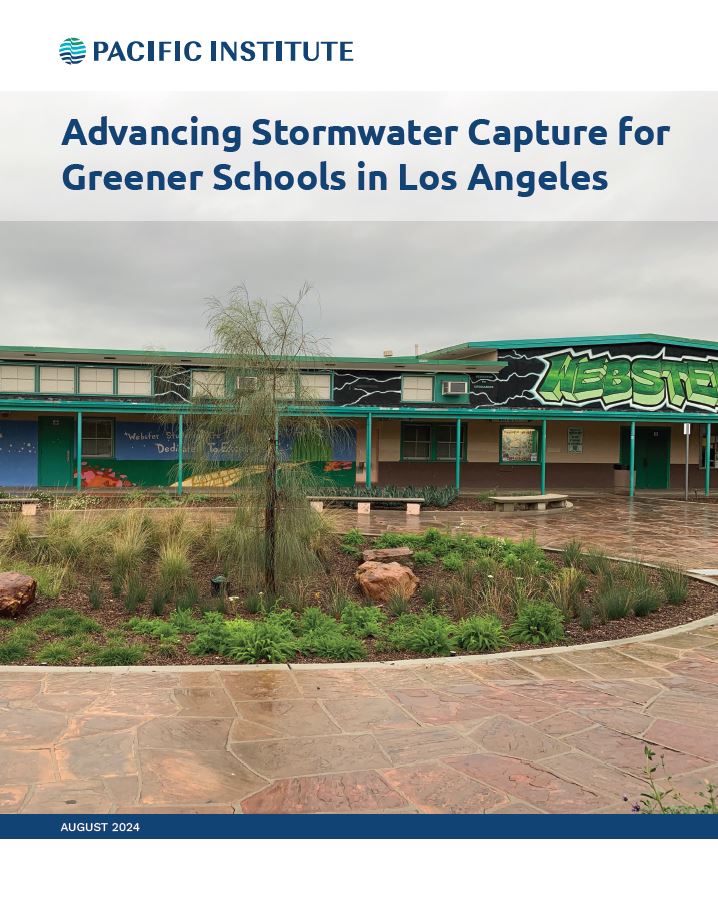Advancing Stormwater Capture for Greener Schools in Los Angeles

Advancing Stormwater Capture for Greener Schools in Los Angeles
Overview
Los Angeles County, the most populated county in the United States, has a vast public school system comprising 80 school districts that serve approximately 1.3 million elementary to high school students. Urban schools are often surrounded by asphalt creating urban heat islands and exacerbating runoff issues during heavy rains. Climate change intensifies these problems, contributing to hotter temperatures, severe droughts, and more intense flooding. Because of these challenges local efforts are underway to create more green space around schools, especially through the careful management of stormwater runoff.
This report, titled “Advancing Stormwater Capture for Greener Schools in Los Angeles,” reveals the significant potential for stormwater capture on public school campuses in Los Angeles County. It estimates that the total stormwater runoff generated from LA County public school campuses is approximately 3.15 billion gallons (9,510 acre-feet) per year. Of this amount, about 2.04 billion gallons (6,190 acre-feet) per year could potentially be captured to augment water supplies and help green school campuses.
The study highlights a local adaptation of the Pacific Institute’s national assessment conducted earlier this year that estimates US Urban Areas have the potential to generate an average of 59.5 million acre-feet of stormwater runoff per year. The study utilizes 2NDNATURE’s Rainsteward™ tool to analyze the multi-benefits of greening schools. It provides a detailed analysis of how greening schoolyards can enhance climate resilience and benefit both students and their surrounding communities.
Key Takeaways
Key takeaways from the report include:
- Watershed Analysis: Of the 10 major watersheds in LA County, the Upper Los Angeles River Watershed tops the list with a stormwater capture potential on public school campuses of 557 million gallons (1,710 acre-feet) per year, accounting for 27.4% of the total capture potential from public school campuses. Other notable watersheds include Upper San Gabriel River (369 million gallons/1,130 acre-feet), Lower San Gabriel River (233 million gallons/715 acre-feet), and Central Santa Monica Bay (216 million gallons/663 acre-feet).
- Multi-Benefit Prioritization: Using the Rainsteward tool, the study demonstrates how the multi-benefits of water supply, water quality, flood reduction, and urban heat mitigation can be used to prioritize school campuses for stormwater capture projects. When considered, these additional criteria highlight opportunities for students and neighboring communities to build resilience to multiple extremes through greening schools and better managing stormwater.
- Pollutant Reduction: Managing stormwater capture on LA County school campuses could prevent approximately 1,220 tons of pollutants from entering local waterways and the ocean each year, significantly improving water quality.
- Stakeholder Engagement: The project involved extensive stakeholder engagement, incorporating insights from the Council for Watershed Health and the Los Angeles office of the Trust for Public Land. These organizations have valuable expertise and experience implementing and advocating for school greening projects in LA County.
Key Recommendations
Key recommendations from the report include:
- State and local programs and policies should broaden the types of benefits and costs considered in planning decisions, requiring the assessment of multiple benefits for all stormwater projects.
- Strengthen partnerships between school districts and community-based organizations to maximize the impact of stormwater management efforts.
- Ensure programs, policies, and funding opportunities prioritize benefits to students.
- Provide school districts with the necessary resources and tools to proactively manage stormwater, transforming it into an asset.

